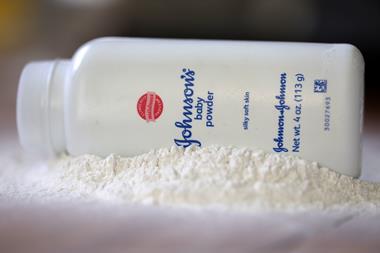Lawsuit claims another study linking talc use to cancer is fraudulent
US healthcare giant Johnson & Johnson (J&J) has launched a second lawsuit against researchers whose studies have connected talc-based powders and cancer, attacking the underlying science.
Earlier this month, J&J’s subsidiary LTL Management, which was formed in 2021 to assume the company’s liabilities in talc litigation, sued two pathologists affiliated with Peninsula Pathology Associates in Virginia, US – Theresa Emory and John Maddox – and Richard Kradin, a pathologist and pulmonologist who is now retired from the Harvard University-affiliated Massachusetts General Hospital Cancer Center.
The article that the three jointly published in 2020 concluded that mesothelioma can develop following exposures to cosmetic talcum powders, but LTL argues that the paper included false statements, including that cosmetic talc was the only known exposure of the 75 study subjects to asbestos. The company asserts that some individuals in that study had admitted to, and even made claims seeking compensation for, contact with other sources of asbestos. ‘The authors knew that, or recklessly disregarded substantial evidence to the contrary,’ LTL’s complaint states.
The company is seeking monetary damages, including punitive damages, for fraud and other legal infractions, as well as retraction or public correction of the article.
This case sits alongside an ongoing lawsuit by LTL making similar claims about a separate 2019 study led by Jacqueline Moline. All four of these researchers had provided expert testimony against J&J in court, and their studies were cited in lawsuits against J&J.
Mark Lanier, an attorney who represented 22 women in a successful 2018 talc lawsuit against J&J, is not surprised by LTL’s latest action. ‘This is an old tactic of J&J trying to squash scientific opinion through intimidation using its behemoth status,’ he tells Chemistry World. ‘This was done in the 1970s when scientists tried to warn about J&J’s talc containing asbestos,’ Lanier continues. ‘I think this shows a level of audacity, if not desperation.’
Jean Eggen, a professor emerita of law at Widener University in Delaware, US, agrees. ‘There is no doubt that these are aggressive tactics by LTL,’ she says. ‘If such cases were to succeed, it would leave virtually every expert open to claims of fraud whenever the opposing experts disagree or find fault with their opinions,’ Eggen warns. ‘This would have a chilling effect on expert testimony in toxic tort litigation.’
Companies like J&J have much greater resources than university scientists, emphasises Marion Nestle, a professor emerita of nutrition, food studies and public health at New York University. ‘J&J has much deeper pockets than any academic researcher – their incomes aren’t even in the same stratosphere – so if it can break them financially, it will,’ she warns. ‘Doing so will also send a message to other academics that criticising drug companies will have unpleasant consequences.’
Meanwhile, J&J and LTL still face thousands of unresolved US lawsuits relating to talc and cancer. On 18 July, a California jury ruled the company must pay almost $19 billion (£15 billion) to a man who claims his mesothelioma was caused by lifelong exposure to J&J’s talc. The jury awarded compensation to cover medical expenses, but no punitive damages against J&J. Most litigation against LTL and J&J has been frozen while LTL’s proposed bankruptcy settlement is considered in the courts, but this case prceeded owing to the plaintiff’s poor health.
Ed. This story was updated on 20 July to include details of the latest resolved lawsuit

















3 readers' comments